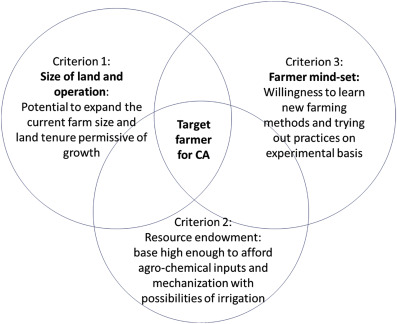Conservation agriculture is a sustainable farming method that preserves soil quality and reduces the use of inputs. It also makes it possible to limit erosion, increase biodiversity and improve farm profitability. However, it can require significant financial investment and adaptation of farming practices. So what are the advantages and disadvantages of conservation agriculture?
Conservation agriculture: benefits and limitations.
Conservation agriculture is a farming method that aims to preserve the environment while increasing crop productivity. It is based on three main practices: reduced tillage, crop rotation and permanent plant cover. These practices reduce soil erosion, increase soil fertility and promote biodiversity.
However, this method also has its limitations. It requires substantial initial investment in equipment and training for farmers. What's more, results can be mixed, depending on the region and type of crop. Finally, conservation agriculture needs to be accompanied by public policies and support programs to encourage its widespread adoption.
Conservation agriculture is therefore a method which offers advantages for the environment and agricultural production, but which requires considerable effort and political support if it is to be adopted on a large scale.
Marc-André Selosse - Soils also have an ecology - Journée PNDAR-CASDAR 2023
[arve url="https://www.youtube.com/embed/gTy4wB557Lc "/]
Intervention Frédéric THOMAS - Improving soil fertility with plant cover crops
[arve url="https://www.youtube.com/embed/ejoN2vENVIc "/]
What are the benefits of conservation agriculture?
Conservation agriculture has many advantages benefits for farmers and the environment. First of all, it makes it possible to preserve soil quality by limiting tillageThis reduces erosion and improves soil structure. This technique also makes it possible to reduce the use of fertilizers and pesticideswhich contributes to the environmental protection. Finally, the conservation agriculture increases biodiversity by promoting life in the soil and creating habitats for insects and birds.
These benefits are particularly important in a context of climate changeThey enable farming practices to be adapted to current and future environmental conditions. Moreover, the adoption of this technique by farmers can help reduce the impact of agriculture on greenhouse gas emissions.
In short, the conservation agriculture represents a sustainable alternative to conventional farmingwith considerable benefits for farmers, the environment and society as a whole.
What are the advantages and disadvantages of farming?
Conservation agriculture has many advantages benefits for farmers and the environment. First of all, it makes it possible to preserve soil quality by limiting tillageThis reduces erosion and improves soil structure. This technique also makes it possible to reduce the use of fertilizers and pesticideswhich contributes to the environmental protection. Finally, the conservation agriculture increases biodiversity by promoting life in the soil and creating habitats for insects and birds.
These benefits are particularly important in a context of climate changeThey enable farming practices to be adapted to current and future environmental conditions. Moreover, the adoption of this technique by farmers can help reduce the impact of agriculture on greenhouse gas emissions.
In short, the conservation agriculture represents a sustainable alternative to conventional farmingwith considerable benefits for farmers, the environment and society as a whole.
What are the three pillars of conservation agriculture?
The three pillars of conservation agriculture are permanent ground coverthe crop rotation and the organic matter management.
Permanent soil cover means keeping vegetation in place throughout the year, protecting the soil against erosion and promoting biological activity.
Crop rotation is an agricultural practice that involves alternating crops on the same plot of land. This reduces disease and pest pressure on crops, improves soil fertility and preserves soil structure.
Organic matter management consists in maintaining and improving the soil's organic matter content. This can be achieved through practices such as composting, adding manure or growing leguminous plants that fix atmospheric nitrogen in the soil.
What are the fundamentals of conservation agriculture?
Conservation agriculture is a sustainable farming method based on three fundamentals: the permanent ground coverthe crop rotation and the direct cultivation.
Visit permanent ground cover is to maintain a permanent vegetation cover on the soil. This prevents soil erosion, protects biodiversity, promotes water infiltration and maintains soil fertility.
Visit crop rotation consists in alternating crops on the same plot over several years. This practice prevents soil impoverishment and reduces disease and pests.
Finally, the direct cultivation involves sowing crops directly into the plant cover without ploughing the soil. This reduces energy consumption, maintains soil structure and cuts greenhouse gas emissions.
Conservation agriculture is a method of preserving soil and environmental health while ensuring sustainable agricultural production.
What are the main benefits of conservation agriculture for soil health and the environment?
Conservation agriculture is a farming method that preserves soil and environmental health while increasing crop yields. The main advantages of this method are numerous. Firstly, it reduces soil erosion caused by the use of heavy machinery and intensive ploughing. Secondly, it promotes biodiversity by leaving crop residues on the soil and avoiding the use of chemicals that can kill beneficial soil organisms.
In addition, conservation agriculture helps preserve water resources by limiting the use of irrigation water and encouraging water infiltration into the soil. It also allows more carbon to be stored in the soil, helping to combat climate change.
Finally, this farming method reduces production costs by using fewer chemical inputs, limiting fuel consumption for farm machinery and increasing crop durability. In short, conservation agriculture is an effective solution for improving soil health, protecting the environment and guaranteeing sustainable yields for farmers.
How can conservation agriculture be reconciled with the economic challenges facing farms?
Conservation agriculture is an approach that aims to protect soils and reduce erosion, while improving their fertility. However, this method requires significant investment of time and resources to implement and maintain. Visit reconcile conservation agriculture with the economic stakes of farming operations, it is therefore necessary to find a balance between costs and benefits.
Fortunately, some conservation farming practices can also have positive effects on farmers' incomes. For example, the use of techniques such as crop rotation can not only preserve soils, but also increase yields and profits in the long term. What's more, by using efficient irrigation techniques and optimizing water management, farmers can reduce their water and energy costs, which can also improve their profitability.
Finally, it is important that governments support farmers in their transition to conservation agriculture practices by offering subsidies for initial investments and providing training and advice. By working together to find innovative solutions, farmers can continue to operate in an economically viable way while preserving the environment.
What are the main drawbacks and limitations of conservation agriculture for farmers and consumers?
Conservation agriculture is a sustainable farming method that aims to reduce soil disturbance and improve crop quality. However, it also presents certain drawbacks and limitations for farmers and consumers alike.
One of the main disadvantages of conservation agriculture is that it can require significant modification of traditional farming practices, which can take time and require investment in equipment and training. As a result, some farmers may be reluctant to adopt this method.
What's more, conservation agriculture can also limit the quantity of crops that can be produced on the same plot of land. This can lead to a drop in yields and therefore a reduction in income for farmers.
For consumers, the main limitations of conservation agriculture may be the following limited range of products and higher prices due to the additional costs associated with this farming method.
Ultimately, it's important for farmers to carefully weigh up the costs and benefits of adopting conservation agriculture, and for consumers to consider whether the environmental benefits justify the higher financial costs.
In conclusion, theconservation agriculture is an agricultural practice that has many advantages, such as reduced soil erosion and the preserving biodiversity. It also enables efficient management of water resources and a lower production costs. However, it can also present certain disadvantagesincluding difficulties controlling weeds and a yield uncertainty. So it's important to weigh up the pros and cons before adopting this farming practice. In short, conservation agriculture can be beneficial for both farmers and the environment, but it requires careful planning and management to get the most out of it.








